2020-10-15 - Nº 285
Editorial
Esta é a Newsletter Nº 285 que se apresenta com o mesmo formato que as anteriores. Se gostar da Newsletter partilhe-a!
Todas as Newsletters encontram-se indexadas no link.
Esta Newsletter tem os seguintes tópicos:
Faz hoje anos que nascia, em 1608, o matemático e físico italiano Evangelista Torricelli. Ele inventou o barómetro e cujo trabalho em geometria auxiliou no eventual desenvolvimento do cálculo integral. Inspirado pelos escritos de Galileu, ele escreveu um tratado sobre mecânica, De Motu ("Movimento Concernente"), que impressionou Galileu. Ele também desenvolveu técnicas para a produção de lentes telescópicas. A experiência do barómetro usando "mercúrio" para encher um tubo e depois invertido num prato de mercúrio, realizado na primavera de 1644, tornou o nome de Torricelli famoso. O mérito do cientista italiano foi, antes de tudo, admitir que a causa efectiva da resistência apresentada pela natureza à criação do vácuo (no tubo invertido acima do mercúrio) se devia provavelmente ao peso do ar.
Faz também hoje anos que nascia, em 1829, o astrónomo norte-americano Asaph Hall. Ele foi responsável pela descoberta e baptismo das duas luas de Marte, Fobos e Deimos, e calculou suas órbitas. Nascido em Goshen, Connecticut, e aprendiz de carpinteiro aos 16 anos, ele tinha paixão por geometria e álgebra. Hall obteve uma posição no Observatório de Harvard em Cambridge, Massachusetts, em 1857 e tornou-se um calculador especialista em órbitas. Em Agosto de 1862, ele juntou-se à equipa do Observatório Naval em Washington, DC, onde fez as suas descobertas, em meados de Agosto de 1877, usando o telescópio refractor "Grande Equatorial" de 26 polegadas do Observatório, então o maior do seu tipo no mundo.
Em 1582, este foi o primeiro dia do calendário gregoriano, por decreto do Papa Gregório XIII, nos países católicos da Itália, Espanha, Portugal e Polónia, que realinharam o calendário com os equinócios. O resto do mundo ainda estava a usar o calendário juliano e reconheceu o dia como 5 de Outubro de 1582.
Em 1939, foi escrito num memorando que seria possível construir um computador com tubos de vácuo que processaria “10.000 operações por segundo”. A previsão de Helmut Schreyer veio na época em que os computadores estavam a ser construídos com relés para funcionar eletromecanicamente. Ele ajudou Konrad Zuse na construção da calculadora automática Z2 concluída no mesmo ano. A Z2 contava com 800 relés nas unidades aritmética e de controle, além de memória mecânica.
Em 1997, a nave espacial Cassini (carregando a sonda Huygens) foi lançada do Cabo Canaveral. O objectivo da missão era orbitar Saturno, recolhendo dados sobre o próprio planeta gigante, a sua magnetosfera, anéis e luas. Após uma viagem de quatro anos, em 30 de Junho de 2004, a Cassini entrou em órbita a volta de Saturno. No caminho, sobrevoou Vénus, a Terra e Júpiter. Pouco depois da chegada, lançou a sonda Huygens, que pousou na lua Titã. Após duas extensões produtivas, a missão da Cassini foi encerrada em 15 de Setembro de 2017, com um mergulho planeado para queimar na atmosfera de Saturno.
Nesta semana que passou o Linux Kernel 5.9 foi declarado estável, com Linus Torvalds observando "não parece haver nada particularmente assustador aqui", apesar do número de ajustes na semana anterior. Esta versão implementa melhor gestão de memória anónima (malloc'ed); um novo controlador cgroup slab que melhora a utilização do slab, permitindo que os cgroups de memória compartilhem a memória slab; suporte para desfragmentação pró-activa da memória; capacidade de observação da CPU para a classe de agendamento de prazos; suporte para executar programas BPF em pesquisas de sockets; nova chamada de sistema close_range() para fechar intervalos de descritores de ficheiros, suporte para instruções FSGSBASE x86 que fornecem comutação de contexto mais rápida, suporte NFS para atributos estendidos; e suporte no kernel da compressão ZSTD para ramdisk e initramfs. Como sempre, existem muitos outros novos drivers e melhorias, entre os quais há suporte inicial para placas de vídeo AMD Radeon RX 6000 e GPUs Intel Rocket Lake.
Também nesta semana que passou foi anunciada a nova placa BBC micro:bit. A nova BBC micro:bit é um dispositivo mais poderoso que combina todos os mesmos recursos da placa original e adiciona microfone embutido, alto-falante, sensor de toque capacitivo e botão de economia de energia. Os desenvolvimentos mais recentes também fornecem uma plataforma técnica actualizada projectada para fornecer recursos para a introdução de projectos futuros que permitirão futuros projectos de educação de IA e ML nas escolas. O Processador foi substituído pelo Nordic nRF52833, tendo como consequência a sua Flash foi duplicada para 512KB e a memória RAM passou para 128KB, sendo o suporte de Bluetooth passado para 5.0. Foi igualmente aumentada a corrente disponível para dispositivos para 200mA, entre outras melhorias já referidas.
Também nesta semana que passou a missão Soyuz MS-17 foi lançada no dia 14 a partir do cosmodromo de Baikonur, no Cazaquistão. Os três astronautas, uma norte-americana e dois russos percorreram os cerca de 400 km em apenas 3 horas e 3 minutos. A Acoplagem decorreu a cerca 400 km de altitude por cima do Brasil. Esta missão de duas órbitas foi modelada há algum tempo, tendo sido testada com veículos de carga.
Na Newsletter desta semana apresentamos diversas noticias, artigos científicos assim como projetos de maker. É apresentada a revista newelectronics de 13 Outubro.
 João Alves ([email protected])
João Alves ([email protected])
O conteúdo da Newsletter encontra-se sob a licença  Creative Commons Attribution-NonCommercial-ShareAlike 4.0 International License.
Creative Commons Attribution-NonCommercial-ShareAlike 4.0 International License.
Novidades da Semana

Eight release candidates later and it's out: New hardware and more AMD in Linux 5.9
"Linux 5.9 has been declared stable, with Linus Torvalds observing "there doesn't really seem to be anything particularly scary in here" despite the number of tweaks in the last week. Although more lines had been changed than he would have preferred, the chief maintainer saw little reason for delay so version 5.9 is upon us. The bulk of the changes this time around lurked in "networking stuff", according to Torvalds, and there have been eight release candidates needed to get to this point. As for version 5.9 itself, there is initial support for AMD's Radeon RX 6000 graphics cards and Intel Rocket Lake GPUs. On the eve of release, the team at Phoronix noted that the AMDGPU graphics driver accounted for more than 10 per cent of the lines of code lurking within the source tree for the 5.9 kernel (although a huge chunk of that was actually auto-generated header files). For 5.9, the deadline scheduling class is now aware of the capacity of each CPU and FSGSBASE x86 instructions see support, bringing with it the potential for a jump in performance." [...]
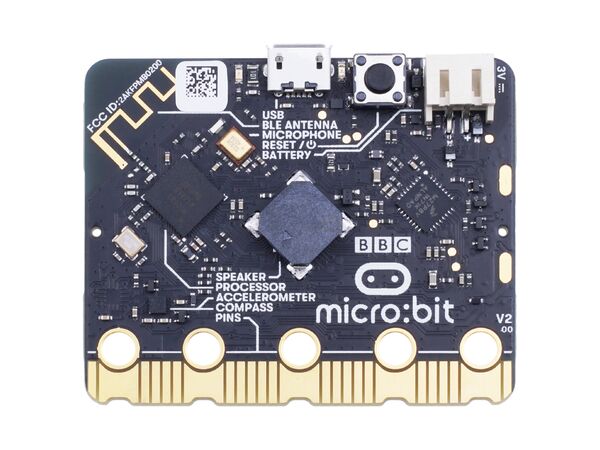
New BBC micro:bit announced
"Discover the simplicity of teaching with sound and touch with the new BBC micro:bit. Announced today and available from November 2020 the latest micro:bit comes with built-in speaker, microphone and capacitive touch sensor. The original BBC micro:bit was created at the BBC in partnership with world-class technology and product design co-creators. In 2016 the BBC "Make it Digital" campaign gave away one million micro:bits for free to students across the UK as computing was added to the school curriculum. BBC Director General Tim Davie said: “From the very beginning the BBC’s purpose has been to inform, educate and entertain – qualities which are all reflected in the micro:bit project. Since its launch through our Make it Digital campaign, it has helped transform digital skills and learning." [...]

Soyuz crew launches on 'ultrafast' two-orbit flight to space station
"An American astronaut and two Russian cosmonauts have launched to the International Space Station just ahead of and to extend 20 years of a continuous human presence in Earth orbit. Kate Rubins of NASA, together with Sergey Ryzhikov and Sergey Kud-Sverchkov of Roscosmos, lifted off on Russia's Soyuz MS-17 spacecraft from the Baikonur Cosmodrome in Kazakhstan on Wednesday (Oct. 14). Their launch, atop a Soyuz-2.1a rocket, began at 1:45 a.m. EDT (0545 GMT; 10:45 a.m. local Kazakh time). The three crewmates are docked their Soyuz at the station's Rassvet module at 4:48 a.m. EDT (0848 GMT) after a two-orbit rendezvous, wrapping up a three-hour, three-minute trip. This mission marks the first crewed use of an "ultrafast" flight plan, which will see the Soyuz arrive at the space station within three hours of its launch, rather than following an earlier expedited six-hour track or two-day path. "This two-orbit rendezvous has been modeled for quite a while now." [...]
Outras Notícias

Microchip Technology Introduces Its First Trust&GO Wi-Fi 32-bit MCU Module with Advanced Peripheral Options
"Pre-provisioned for market-leading cloud platforms, the all-in-one WFI32E01PC Trust&GO solution delivers powerful MCU functionality and verifiable identity As the Internet of Things (IoT) expands beyond home automation and drives deeper into home control – including Heating, Ventilation and Air Conditioning (HVAC), garage doors and fans – and grows in building and industrial automation, the need for highly integrated, reliable and secured Industrial IoT (IIoT) connectivity is greater than ever. Microchip Technology (Nasdaq: MCHP) today announced the first-ever Wi-Fi® microcontroller (MCU) module with Microchip’s Trust&GO-enabled unique, verifiable identity. For developers designing secure IIoT systems, Microchip’s highly integrated WFI32E01PC is a Trust&GO secured platform-enabled Wi-Fi MCU module that is pre-provisioned for cloud platforms. The WFI32E01PC is compliant to Wi-Fi Alliance (WFA) specification and fully certified with the following world regulatory agencies: Federal Communications Commission (FCC), Industry Canada (IC) and European Radio Equipment Directive (RED). Microchip’s Trust&GO platform inside the WFI32E01PC streamlines the process of network authentication using secure element technology, which is preconfigured and pre-provisioned for cloud authentication. Unlike existing devices, Microchip’s new technology includes a premium PIC32 MCU core, rich peripherals and a proven hardware security platform – enabling it not only to provide Wi-Fi but also to serve as a powerful MCU core for the entire IIoT system." [...]

Maxim Integrated’s Automotive Buck-Boost Controller Enables Automotive USB Power Delivery Ports with Industry’s Smallest Solution Size and Lowest Cost
"MAX25430 slashes design size up to 40 percent and eliminates microcontrollers, metal enclosures and heat sinks for 25 percent lower cost than competitive solutions Designers of automotive chargers now have the industry’s smallest and lowest-cost solution with the MAX25430 100W USB Power Delivery (PD) buck-boost controller and protector from Maxim Integrated Products, Inc. (NASDAQ: MXIM). As the industry’s most integrated solution, the MAX25430 can reduce design size up to 40 percent compared to competitive solutions and offer the industry’s lowest cost for increasing the number of USB PD ports in vehicles. Details about Maxim Integrated’s automotive USB PD solutions › Order MAX25430 or learn more › Hi-res image › Automotive multimedia hubs, including rear-seat entertainment modules and head units, are all expanding in capability as more USB PD chargers are integrated into passenger vehicle cabins. However, there are size, cost and power constraints—and the MAX25430 addresses all of these. The MAX25430 integrates a USB Type C Port Controller (TCPC) power regulator, VCONN cable power supply, buck-boost and protection thereby eliminating heat-sink requirements and metal box enclosures to further slash design size by 40 percent compared to competitive multi-IC solutions. In addition, bill-of-materials (BOM) costs are also reduced by 25 percent compared to competitive solutions." [...]

Renesas Announces Buck-Boost DC/DC Converter with Ultra-Low Quiescent Current for Powering Sensors, MCUs, Wireless Devices, and Other Components
"Renesas Electronics Corporation (TSE:6723), a premier supplier of advanced semiconductor solutions, today introduced the ISL9122A, a flexible buck-boost switching regulator with bypass mode that provides ultra-low quiescent current (IQ) for powering sensors, microcontrollers (MCUs), wireless devices, and other system components. Operating with battery output from 1.8V to 5.5V, the ISL9122A extends the battery life of smart IoT devices powered by coin-cell, lithium and multiple series alkaline batteries. Target applications include wireless earbuds, fitness bands, smart watches, water and gas meters, portable medical devices, and a wide range of battery-operated smart IoT devices. The ISL9122A buck-boost switching regulator implements dynamic voltage scaling (DVS) in I2C programmable 25mV steps to optimize system power consumption. The regulator’s power boost up to 5.375V maximizes RF capabilities of IoT devices across their battery range. Its PFM and PWM functionality maximizes efficiency over the whole output current range." [...]

This Transforming Rover Can Explore the Toughest Terrain
"A rover trundles over rocky terrain, its four metal wheels clattering along until they encounter a seemingly insurmountable hazard: a steep slope. Down below is a potential trove of science targets. With a typical rover, the operators would need to find another target, but this is DuAxel, a robot built for situations exactly like this. The rover is actually made of a pair of two-wheeled rovers, each called Axel. To divide and conquer, the rover stops, lowers its chassis and anchors it to the ground before essentially splitting in two. With the rear half of DuAxel (short for "dual-Axel") firmly in place, the forward half undocks and rolls away on a single axle." [...]
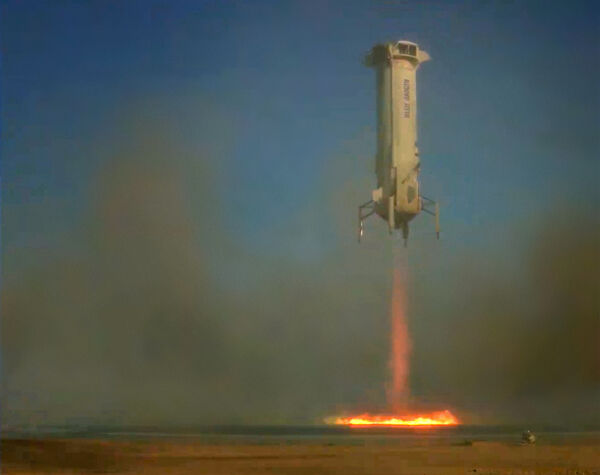
New Shepard Successfully Completes Mission with NASA Precision Lunar Landing Technology Onboard
"Blue Origin successfully completed the 13th New Shepard mission to space and back, and the 7th consecutive flight for this particular vehicle, a record. Catch the mission webcast replay on Blue Origin's YouTube page. There were 12 payloads onboard including the Deorbit, Descent, and Landing Sensor Demonstration under the NASA Tipping Point partnership. The lunar landing sensor demo was the first payload to be mounted on the exterior of a New Shepard booster and tested technology designed to achieve high accuracy landing. This will enable long-term lunar exploration, as well as future Mars missions. New Shepard landing on the pad in West Texas on October 13, 2020, with the NASA Lunar Landing Sensor Demo onboard." [...]
Ciência e Tecnologia

Solar-powered system extracts drinkable water from “dry” air
"MIT engineers have made their initial design more practical, efficient, and scalable. Researchers at MIT and elsewhere have significantly boosted the output from a system that can extract drinkable water directly from the air even in dry regions, using heat from the sun or another source. The system, which builds on a design initially developed three years ago at MIT by members of the same team, brings the process closer to something that could become a practical water source for remote regions with limited access to water and electricity. The findings are described today in the journal Joule, in a paper by Professor Evelyn Wang, who is head of MIT’s Department of Mechanical Engineering; graduate student Alina LaPotin; and six others at MIT and in Korea and Utah. The earlier device demonstrated by Wang and her co-workers provided a proof of concept for the system, which harnesses a temperature difference within the device to allow an adsorbent material — which collects liquid on its surface — to draw in moisture from the air at night and release it the next day. When the material is heated by sunlight, the difference in temperature between the heated top and the shaded underside makes the water release back out of the adsorbent material." [...]

Room-temperature superconductor? Rochester lab sets new record toward long-sought goal
"University physical scientists synthesize new superconducting material, developing a process that may help ‘break down barriers and open the door to many potential applications.’ Compressing simple molecular solids with hydrogen at extremely high pressures, University of Rochester engineers and physicists have, for the first time, created material that is superconducting at room temperature. Featured as the cover article in the journal Nature, the work was conducted by the lab of Ranga Dias, an assistant professor of mechanical engineering and of physics and astronomy. Dias says developing materials that are superconducting—without electrical resistance and expulsion of magnetic field at room temperature—is the “holy grail” of condensed matter physics. Sought for more than a century, such materials “can definitely change the world as we know it,” Dias says. In setting the new record, Dias and his research team combined hydrogen with carbon and sulfur to photochemically synthesize simple organic-derived carbonaceous sulfur hydride in a diamond anvil cell, a research device used to examine miniscule amounts of materials under extraordinarily high pressure. The carbonaceous sulfur hydride exhibited superconductivity at about 58 degrees Fahrenheit and a pressure of about 39 million pounds per square inch (psi)." [...]
New piece of the silicon-circle puzzle discovered
"Samples from the Mariana Trench reveal sources for heavy silicon isotopes 12 October 2020 / Kiel. In nature, compounds of the element silicon play a decisive role in the formation of rocks and also in the climate system due to their connection to the carbon cycle. However, lacking information on sinks and sources of the element, parts of the oceanic silicon cycle cannot yet be satisfactorily modeled. Today, researchers of the GEOMAR Helmholtz Centre for Ocean Research Kiel have published a study in the international journal Nature Communications that identifies an important source of certain silicon isotopes whose values in some ocean basins could not be explained so far. Nowadays the element silicon is almost synonymous with high-tech industry and digitalization. As a component of microelectronics, it is so fundamental that it was chosen to name the birthplace of many global IT groups: Silicon Valley in California." [...]
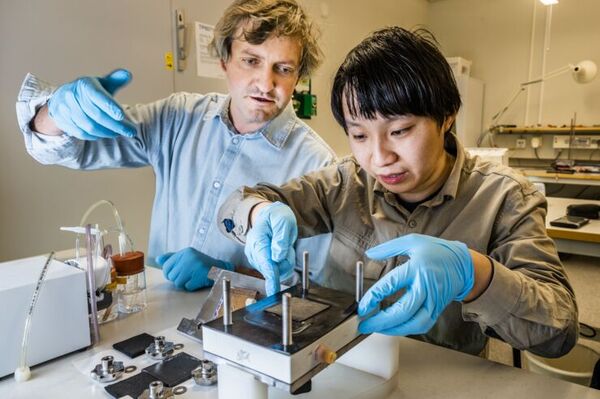
LiU researchers first to develop an organic battery
"Researchers at the Laboratory of Organic Electronics have for the first time demonstrated an organic battery. It is of a type known as a “redox flow battery”, with a large capacity that can be used to store energy from wind turbines and solar cells, and as a power bank for cars. Redox flow batteries are stationary batteries in which the energy is located in the electrolyte, outside of the cell itself, as in a fuel cell. They are often marketed with the prefix “eco”, since they open the possibility of storing excess energy from, for example, the sun and wind. Further, it appears to be possible to recharge them an unlimited number of times. However, redox flow batteries often contain vanadium, a scarce and expensive metal." [...]
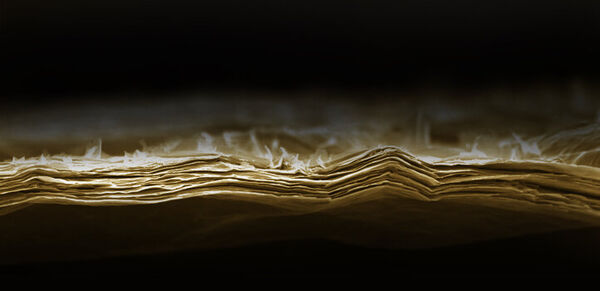
Nanomaterial acts as a molecular thermometer
"A layered material developed by KAUST researchers can act as a precise temperature sensor by exploiting the same principle used in biological ion channels. Human cells possess various proteins that act as channels for charged ions. In the skin, certain ion channels rely on heat to drive a flow of ions that generates electrical signals, which we use to sense the temperature of our surroundings. Inspired by these biological sensors, KAUST researchers prepared a titanium carbide compound (Ti3C2Tx) known as an MXene, which contains multiple layers just a few atoms thick. Each layer is covered with negatively charged atoms, such as oxygen or fluorine. “These groups act as spacers to keep neighboring nanosheets apart, allowing water molecules to enter the interplanar channels,” says KAUST postdoc Seunghyun Hong, part of the team behind the new temperature sensor." [...]
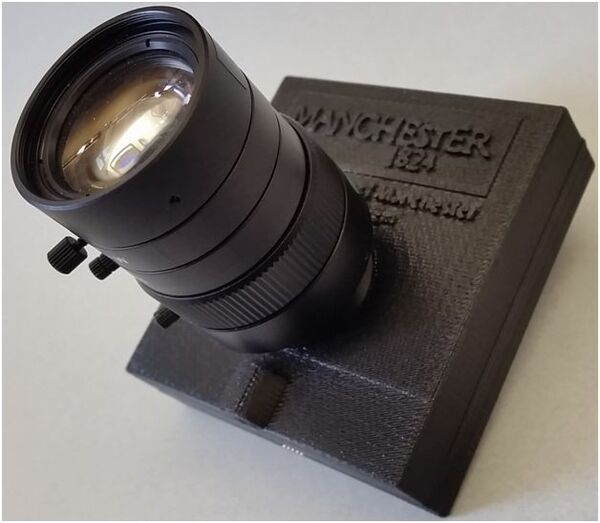
Cameras that can learn
"Intelligent cameras could be one step closer thanks to a research collaboration between the Universities of Manchester and Bristol who have developed cameras that can learn and understand what they are seeing. Roboticists and artificial intelligence (AI) researchers know there is a problem in how current systems sense and process the world. Currently they are still combining sensors, like digital cameras that are designed for recording images, with computing devices like graphics processing units (GPUs) designed to accelerate graphics for video games. This means AI systems perceive the world only after recording and transmitting visual information between sensors and processors. But many things that can be seen are often irrelevant for the task at hand, such as the detail of leaves on roadside trees as an autonomous car passes by. However, at the moment all this information is captured by sensors in meticulous detail and sent clogging the system with irrelevant data, consuming power and taking processing time." [...]
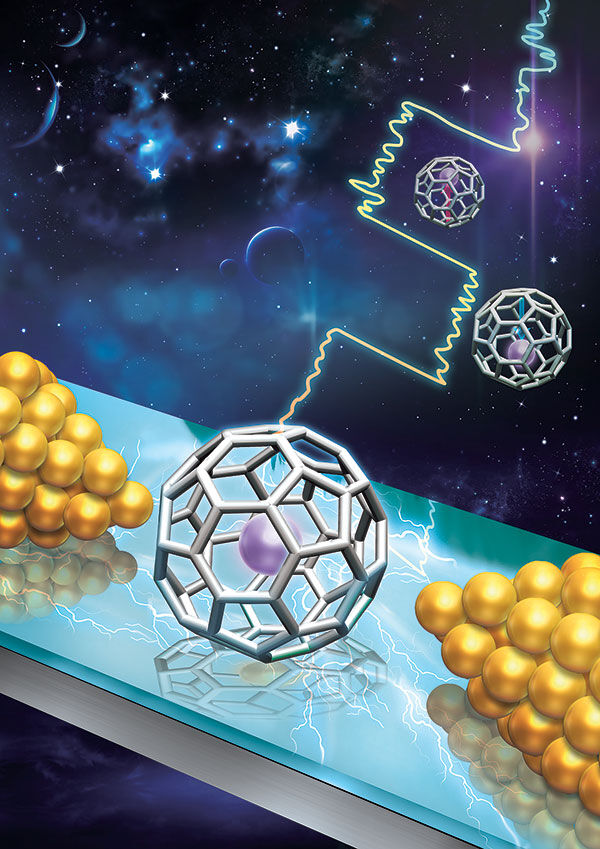
Researchers Create a Single-Molecule Switch – a Step Toward Ever-Smaller Electronics
"A team of researchers has demonstrated for the first time a single-molecule electret - a device that could be one of the keys to molecular computers. Smaller electronics are crucial to developing more advanced computers and other devices. This has led to a push in the field toward finding a way to replace silicon chips with molecules, an effort that includes creating single-molecule electret - a switching device that could serve as a platform for extremely small non-volatile storage devices. Because it seemed that such a device would be so unstable, however, many in the field wondered whether one could ever exist. Along with colleagues at Nanjing University, Renmin University, Xiamen University, and Rensselaer Polytechnic Institute, Mark Reed, the Harold Hodgkinson Professor of Electrical Engineering & Applied Physics demonstrated a single-molecule electret with a functional memory. The results were published Oct. 12 in Nature Nanotechnology." [...]

Death by Spaghettification: Scientists Record Last Moments of Star Devoured by a Black Hole
"A rare blast of light, emitted by a star as it is sucked in by a supermassive black hole, has been spotted by scientists using telescopes from around the world. The phenomenon, known as a tidal disruption event, is the closest flare of its kind yet recorded, occurring just 215 million light-years from Earth. It is caused when a star passes too close to a black hole and the extreme gravitational pull from the black hole shreds the star into thin streams of material – a process called ‘spaghettification’. During this process some of the material falls into the black hole, releasing a bright flare of energy which astronomers can detect. Tidal disruption events are rare and not always easy to study because they are usually obscured by a curtain of dust and debris. An international team of scientists led by the University of Birmingham were able to study this event in unprecedented detail because it was detected just a short time after the star was ripped apart." [...]

A new approach boosts lithium-ion battery efficiency and puts out fires, too
"Adding polymers and fireproofing to a battery’s current collectors makes it lighter, safer and about 20% more efficient. Menlo Park, Calif. — In an entirely new approach to making lithium-ion batteries lighter, safer and more efficient, scientists at Stanford University and the Department of Energy’s SLAC National Accelerator Laboratory have reengineered one of the heaviest battery components – sheets of copper or aluminum foil known as current collectors – so they weigh 80% less and immediately quench any fires that flare up. If adopted, the researchers said, this technology could address two major goals of battery research: extending the driving range of electric vehicles and reducing the danger that laptops, cell phones and other devices will burst into flames. This is especially important when batteries are charged super-fast, creating more of the types of battery damage that can lead to fires. The research team described their work in Nature Energy today. “The current collector has always been considered dead weight, and until now it hasn’t been successfully exploited to increase battery performance,” said Yi Cui, a professor at SLAC and Stanford and investigator with the Stanford Institute for Materials and Energy Sciences (SIMES) who led the research." [...]
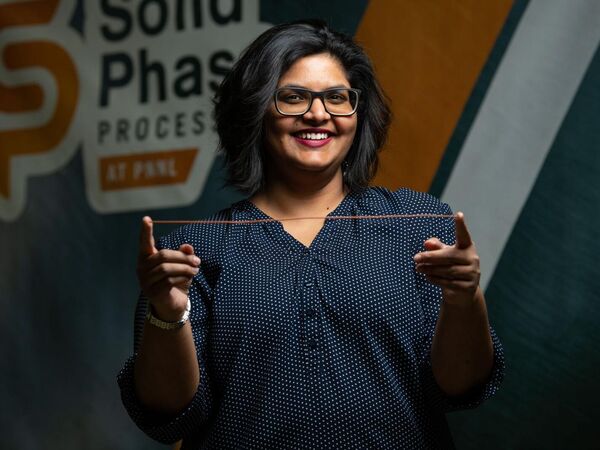
“Better” Copper Means Higher-Efficiency Electric Motors
"New manufacturing process yields highest conductivity copper composites at bulk scale Researchers at Pacific Northwest National Laboratory (PNNL) have increased the conductivity of copper wire by about five percent. That may seem like a small amount but it can make a big difference in motor efficiency. Higher conductivity also means that less copper is needed for the same efficiency, which can reduce the weight and volume of various components that are expected to power our future electric vehicles. The laboratory teamed with General Motors to test out the souped-up copper wire for use in vehicle motor components. As part of a cost-shared research project, the team validated the increased conductivity and found that it also has higher ductility—the ability to stretch farther before it breaks. In other physical properties, it behaved just like regular copper so it can be welded and subjected to other mechanical stresses with no degradation of performance." [...]

Natural fibres threaded into satellites for safer missions
"A natural fibre that once wrapped early Egyptian mummies and was worn by Roman aristocrats has found a space-age purpose. Threading fibres from the flax plant through satellite panel material can help space missions burn up more rapidly during atmospheric reentry – making their disposal safer for people and property on the ground. ESA’s detailed testing of this natural-fibre composite has helped it find wider terrestrial uses in turn, including inside McLaren Racing’s Formula 1 cars. Fibres from the flax plant, cultivated in Europe since the Stone Age, are weaved to make linen. An ESA project with Swiss companies Bcomp and RUAG looked into substituting them for carbon fibres, which are employed to make leading composite material ‘carbon fibre reinforced plastic’ (CFRP). A strong yet light material, CFRP resembles reinforced concrete, where steel bars are added to a concrete mix in order to strengthen it." [...]
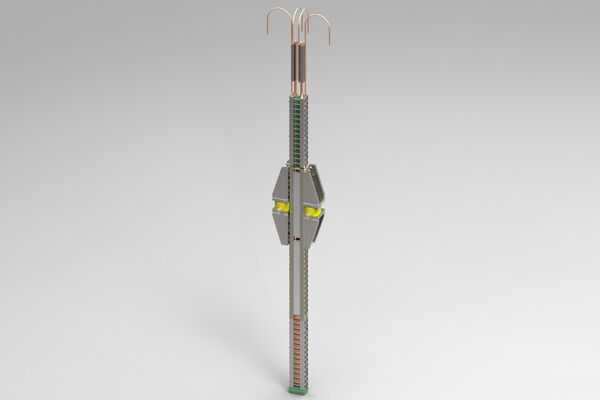
Superconductor technology for smaller, sooner fusion
"MIT-Commonwealth Fusion Systems demonstration of new superconducting cable is a key step on the high-field path to compact fusion. Scientists have long sought to harness fusion as an inexhaustible and carbon-free energy source. Within the past few years, groundbreaking high-temperature superconductor technology (HTS) sparked a new vision for achieving practical fusion energy. This approach, known as the high-field pathway to fusion, aims to generate fusion in compact devices on a shorter timescale and lower cost than alternative approaches. A key technical challenge to realizing this vision, though, has been getting HTS superconductors to work in an integrated way in the development of new, high-performance superconducting magnets, which will enable higher magnetic fields than previous generations of magnets, and are central to confining and controlling plasma reactions. Now a team led by MIT’s Plasma Science and Fusion Center (PSFC) and MIT spinout company Commonwealth Fusion Systems (CFS), has developed and extensively tested an HTS cable technology that can be scaled and engineered into the high-performance magnets." [...]
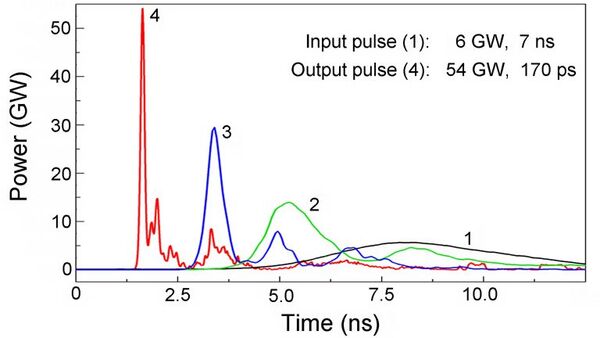
Record High Values of Peak Power with Picosecond Generators
"Powerful picosecond generators are in demand in various fields of experimental electrophysics to produce ultrashort electron beams and X-ray pulses in vacuum diodes and to form runaway electron flows in gases. They also have applications in high-power microwave electronics, but researchers are constantly striving to obtain shorter and more powerful pulses. In Review of Scientific Instruments, by AIP Publishing, scientists showed compact solid-state pulse generators could generate electrical pulses of less than one-billionth of a second in duration and up to 50 billion watts in power. “For comparison, the most powerful hydroelectric power plant in China has an output power of 22.5 billion watts,” said Sergei Rukin, one of the authors. Improving picosecond generators and mastering higher peak power levels in the picosecond range sets the groundwork for new applications in the coming years. “This also happened with the development of powerful nanoscecond pulsed devices during the last 60 years,” said Rukin." [...]

Winners and losers of energy transition
"Accounting for multiple social aims other than costs is critical for transitioning from fossil fuels to renewable electricity. A new study by UNIGE proposes a viable compromise. The European Green Deal aims to drastically reduce greenhouse gas emissions in the electricity sector, which could have substantial economic and social impacts across Central European regions. Some regions might benefit more than others from new employment opportunities and from reduced air pollution, while others face threats to employment from phasing out coal and nuclear power plants. Such a transition to renewable electricity thus risks creating new regional winners and losers. In a study published in Nature Communications, scientists from the University of Geneva (UNIGE) quantify regional impacts associated with Central European electricity targets, as well as regional inequalities in costs, jobs, greenhouse gas and particulate matter emissions, and land use." [...]

Bringing a Power Tool from Math into Quantum Computing
"Scientists design a novel quantum circuit that calculates the fast Fourier transform, an indispensable tool in all fields of engineering. The Fourier transform is a mathematical operation essential to virtually all fields of physics and engineering. Although there already exists an algorithm that computes the Fourier transform in quantum computers, it is not versatile enough for many practical applications. In a recent study, scientists from Tokyo University of Science tackle this problem by designing a novel quantum circuit that calculates the Fourier transform in a much quicker, versatile, and more efficient way. The Fourier transform is an important mathematical tool that decomposes a function or dataset into a its constituting frequencies, much like one could decompose a musical chord into a combination of its notes. It is used across all fields of engineering in some form or another and, accordingly, algorithms to compute it efficiently have been developed-that is, at least for conventional computers." [...]
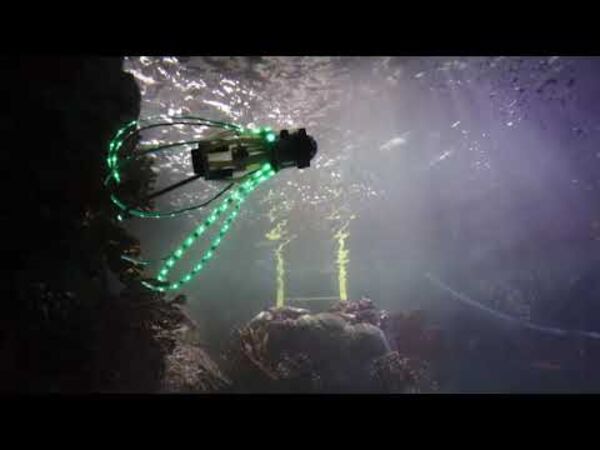
This 'squidbot' jets around and takes pics of coral and fish
"Engineers at the University of California San Diego have built a squid-like robot that can swim untethered, propelling itself by generating jets of water. The robot carries its own power source inside its body. It can also carry a sensor, such as a camera, for underwater exploration. The researchers detail their work in a recent issue of Bioinspiration and Biomimetics. “Essentially, we recreated all the key features that squids use for high-speed swimming,” said Michael T. Tolley, one of the paper’s senior authors and a professor in the Department of Mechanical and Aerospace Engineering at UC San Diego. “This is the first untethered robot that can generate jet pulses for rapid locomotion like the squid and can achieve these jet pulses by changing its body shape, which improves swimming efficiency.” This squid robot is made mostly from soft materials such as acrylic polymer, with a few rigid, 3D printed and laser cut parts." [...]
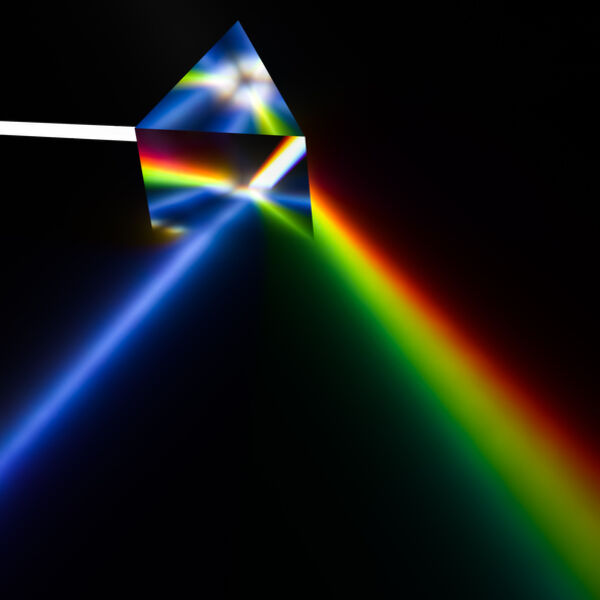
New Method Uses Noise to Make Spectrometers More Accurate
"Optical spectrometers are instruments with a wide variety of uses. By measuring the intensity of light across different wavelengths, they can be used to image tissues or measure the chemical composition of everything from a distant galaxy to a leaf. Now researchers at the UC Davis Department of Biomedical Engineering have come up a with a new, rapid method for characterizing and calibrating spectrometers, based on how they respond to “noise.” Spectral resolution measures how well a spectrometer can distinguish light of different wavelengths. It’s also important to be able to calibrate the spectrometer so that different instruments will give reliably consistent results. Current methods for characterizing and calibrating spectrometers are relatively slow and cumbersome. For example, to measure how the spectrometer responds to different wavelengths, you would shine multiple lasers of different wavelengths on it." [...]
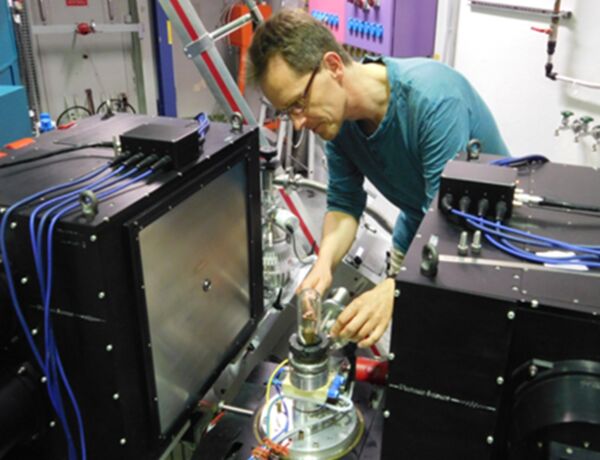
Perovskite materials: Neutrons show twinning in halide perovskites
"Solar cells based on hybrid halide perovskites achieve high efficiencies. These mixed organic-inorganic semiconductors are usually produced as thin films of microcrystals. An investigation with the Laue camera at the neutron source BER II could now clarify that twinning occurs during crystallisation even at room temperature. This insight is helpful for optimising production processes of halide perovskites. A good ten years ago, research teams discovered the class of semi-organic halide perovskites, which are now making a rapid career as new materials for solar cells. The mixed organic-inorganic semiconductors achieved efficiencies of over 25 percent within a few years." [...]
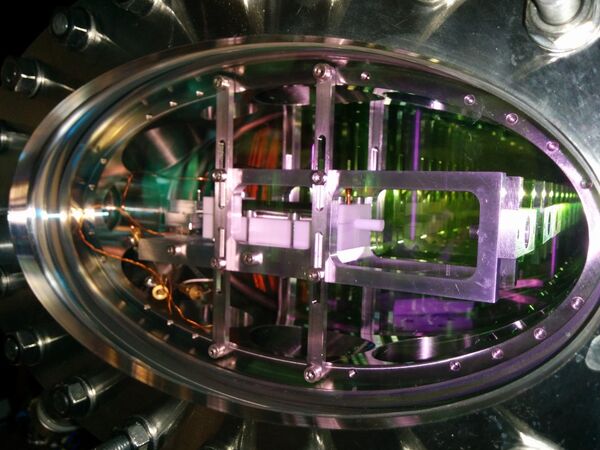
A milestone in quantum physics: Physicists at Mainz University successfully carry out the controlled transport of stored light
"Patrick Windpassinger and his team demonstrate how light stored in a cloud of ultra-cold atoms can be transported by means of an optical conveyor belt A team of physicists led by Professor Patrick Windpassinger at Johannes Gutenberg University Mainz (JGU) has successfully transported light stored in a quantum memory over a distance of 1.2 millimeters. They have demonstrated that the controlled transport process and its dynamics has only little impact on the properties of the stored light. The researchers used ultra-cold rubidium-87 atoms as a storage medium for the light as to achieve a high level of storage efficiency and a long lifetime. "We stored the light by putting it in a suitcase so to speak, only that in our case the suitcase was made of a cloud of cold atoms. We moved this suitcase over a short distance and then took the light out again. This is very interesting not only for physics in general, but also for quantum communication, because light is not very easy to 'capture', and if you want to transport it elsewhere in a controlled manner, it usually ends up being lost," said Professor Patrick Windpassinger, explaining the complicated process." [...]
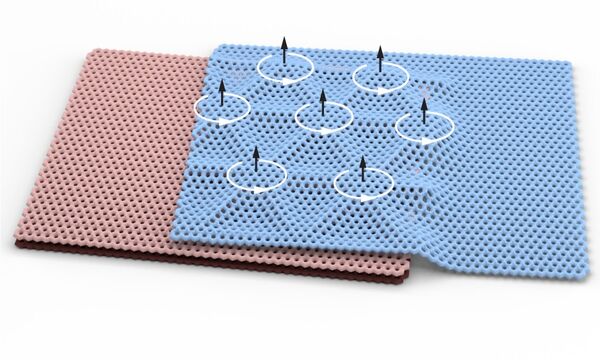
Stacking and Twisting Graphene Unlocks a Rare Form of Magnetism
"Twisting a monolayer and a bilayer sheet of graphene into a three-layer structure leads to new quantum mechanical states. Since the discovery of graphene more than 15 years ago, researchers have been in a global race to unlock its unique properties. Not only is graphene—a one-atom-thick sheet of carbon arranged in a hexagonal lattice—the strongest, thinnest material known to man, it is also an excellent conductor of heat and electricity. Now, a team of researchers at Columbia University and the University of Washington has discovered that a variety of exotic electronic states, including a rare form of magnetism, can arise in a three-layer graphene structure. The findings appear in an article published October 12 in Nature Physics. The work was inspired by recent studies of twisted monolayers or twisted bilayers of graphene, comprising either two or four total sheets." [...]

Scientists find upper limit for the speed of sound
"A research collaboration between Queen Mary University of London, the University of Cambridge and the Institute for High Pressure Physics in Troitsk has discovered the fastest possible speed of sound. The result- about 36 km per second - is around twice as fast as the speed of sound in diamond, the hardest known material in the world. Waves, such as sound or light waves, are disturbances that move energy from one place to another. Sound waves can travel through different mediums, such as air or water, and move at different speeds depending on what they’re travelling through. For example, they move through solids much faster than they would through liquids or gases, which is why you’re able to hear an approaching train much faster if you listen to the sound propagating in the rail track rather than through the air. Einstein’s theory of special relativity sets the absolute speed limit at which a wave can travel, which is the speed of light, and is equal to about 300,000 km per second." [...]

Tetrahedra May Explain Water ‘s Uniqueness
"Researchers at the Institute of Industrial Science at The University of Tokyo sifted through experimental data to probe the possibility that supercooled water has a liquid-to-liquid phase transition between disordered and tetrahedrally structured forms. They found evidence of a critical point based on the cooperative formation of tetrahedra, and show its minor role in water's anomalies. This work shows that water's special qualities--which are essential for life--originate predominantly from the two-state feature. Liquid water is indispensable for life as we know it, yet many of its properties do not conform with the way other fluids behave. Some of these anomalies, such as water's maximum density at 4°C and its large heat capacity, have important implications for living organisms. The origin of these features has sparked fierce debates in the scientific community since the time of Röntgen." [...]

Liquid metals come to the rescue of semiconductors
"Moore’s law is an empirical suggestion describing that the number of transistors doubles every few years in integrated circuits (ICs). However, Moore’s law has started to fail as transistors are now so small that the current silicon-based technologies are unable to offer further opportunities for shrinking. One possibility of overcoming Moore’s law is to resort to two-dimensional semiconductors. These two-dimensional materials are so thin that they can allow the propagation of free charge carriers, namely electrons and holes in transistors that carry the information, along an ultra-thin plane. This confinement of charge carriers can potentially allow the switching of the semiconductor very easily. It also allows directional pathways for the charge carriers to move without scattering and therefore leading to infinitely small resistance for the transistors." [...]
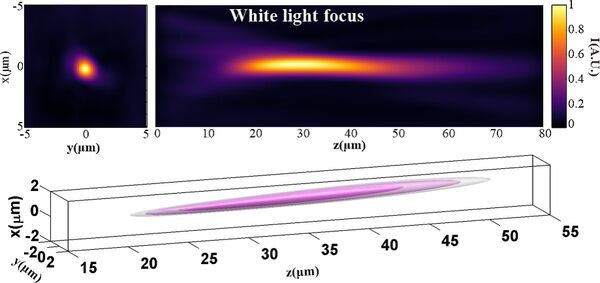
Graphene microbubbles make perfect lenses
"New method generates precisely controlled graphene microbubbles with perfectly spherical curvature for lenses Tiny bubbles can solve large problems. Microbubbles—around 1-50 micrometers in diameter—have widespread applications. They're used for drug delivery, membrane cleaning, biofilm control, and water treatment. They‘ve been applied as actuators in lab-on-a-chip devices for microfluidic mixing, ink-jet printing, and logic circuitry, and in photonics lithography and optical resonators. And they've contributed remarkably to biomedical imaging and applications like DNA trapping and manipulation. Given the broad range of applications for microbubbles, many methods for generating them have been developed, including air stream compression to dissolve air into liquid, ultrasound to induce bubbles in water, and laser pulses to expose substrates immersed in liquids." [...]

What Tiny Surfing Robots Teach Us About Surface Tension
"Propelled by chemical changes in surface tension, microrobots surfing across fluid interfaces lead researchers to new ideas. Spend an afternoon by a creek in the woods, and you’re likely to notice water striders — long-legged insects that dimple the surface of the water as they skate across. Or, dip one side of a toothpick in dish detergent before placing it in a bowl of water, and impress your grade schooler as the toothpick gently starts to move itself across the surface. Both situations illustrate the concepts of surface tension and propulsion velocity. At Michigan Technological University, mechanical engineer Hassan Masoud and PhD student Saeed Jafari Kang have applied the lessons of the water strider and the soapy toothpick to develop an understanding of chemical manipulation of surface tension. Their vehicle?" [...]
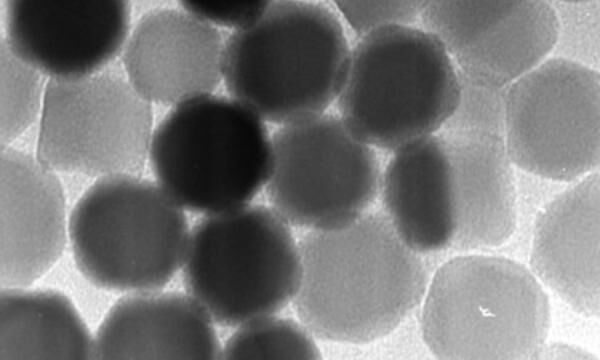
Thermal MagIC: New NIST Project to Build Nano-Thermometers Could Revolutionize Temperature Imaging
"Cheaper refrigerators? Stronger hip implants? A better understanding of human disease? All of these could be possible and more, someday, thanks to an ambitious new project underway at the National Institute of Standards and Technology (NIST). NIST researchers are in the early stages of a massive undertaking to design and build a fleet of tiny ultra-sensitive thermometers. If they succeed, their system will be the first to make real-time measurements of temperature on the microscopic scale in an opaque 3D volume — which could include medical implants, refrigerators, and even the human body." [...]

Stretching Makes the Superconductor
"When people imagine “new materials,” they typically think of chemistry. But UConn physicist Ilya Sochnikov has another suggestion: mechanics. Sochnikov works with superconductors. Superconductors are materials that let electricity flow without losing energy. In a normal conductor—say, a power line—electric current is gradually whittled down by friction and loss. We lose as much as 90% of the electricity we generate this way." [...]
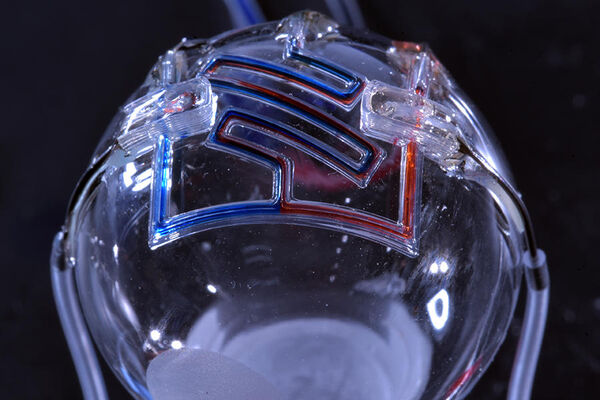
Researchers 3D print unique micro-scale fluid channels used for medical testing
"In a groundbreaking new study, researchers at the University of Minnesota, in collaboration with the U.S. Army Combat Capabilities Development Command Soldier Center, have 3D printed unique fluid channels at the micron scale that could automate production of diagnostics, sensors, and assays used for a variety of medical tests and other applications. The team is the first to 3D print these structures on a curved surface, providing the initial step for someday printing them directly on the skin for real-time sensing of bodily fluids. The research is published in Science Advances, a peer-reviewed scientific journal published by the American Association for the Advancement of Science (AAAS). Microfluidics is a rapidly growing field involving the control of fluid flows at the micron scale (one millionth of a meter). Microfluidics are used in a wide range of application areas including environmental sensing, medical diagnostics (such as COVID-19 and cancer), pregnancy testing, drug screening and delivery, and other biological assays. The global microfluidics market value is currently estimated in the billions of dollars." [...]

Engineers print wearable sensors directly on skin without heat
"An international team of researchers developed a novel technique to produce precise, high-performing biometric sensors Wearable sensors are evolving from watches and electrodes to bendable devices that provide far more precise biometric measurements and comfort for users. Now, an international team of researchers has taken the evolution one step further by printing sensors directly on human skin without the use of heat. Led by Huanyu “Larry” Cheng, Dorothy Quiggle Career Development Professor in the Penn State Department of Engineering Science and Mechanics, the team published their results in ACS Applied Materials & Interfaces. “In this article, we report a simple yet universally applicable fabrication technique with the use of a novel sintering aid layer to enable direct printing for on-body sensors,” said first author Ling Zhang, a researcher in the Harbin Institute of Technology in China and in Cheng’s laboratory. Cheng and his colleagues previously developed flexible printed circuit boards for use in wearable sensors, but printing directly on skin has been hindered by the bonding process for the metallic components in the sensor. Called sintering, this process typically requires temperatures of around 572 degrees Fahrenheit (300 degrees Celsius) to bond the sensor’s silver nanoparticles together." [...]

High-capacity tape for the era of big data
"A new magnetic material and recording process can vastly increase data capacity Although out of sight to the majority of end users, data centers work behind the scenes to run the internet, businesses, research institutions and more. These data centers depend on high-capacity digital storage, the demand for which continues to accelerate. Researchers created a new storage medium and processes to access it that could prove game changing in this sector. Their material, called epsilon iron oxide, is also very robust so can be used in applications where long-term storage, such as archiving, is necessary. It may seem odd to some that in the year 2020, magnetic tape is being discussed as a storage medium for digital data. After all, it has not been common in home computing since the 1980s." [...]
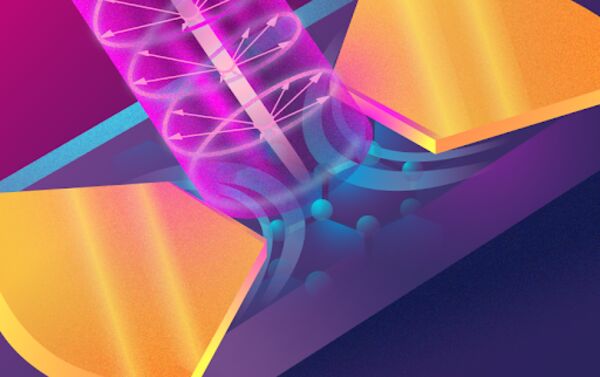
Graphene detector reveals THz light’s polarization
"Physicists have created a broadband detector of terahertz radiation based on graphene. The device has potential for applications in communication and next-generation information transmission systems, security and medical equipment. The study came out in ACS Nano Letters. The new detector relies on the interference of plasma waves. Interference as such underlies many technological applications and everyday phenomena. It determines the sound of musical instruments and causes the rainbow colors in soap bubbles, along with many other effects." [...]

New measurements of the solar spectrum verify Einstein’s theory of General Relativity
"An international team of researchers led by the Instituto de Astrofísica de Canarias (IAC) has measured, with unprecedented accuracy, the gravitational redshift of the Sun, a change in frequency of the lines in the solar spectrum which is produced when the light escapes from the gravitational field of the Sun on its way to Earth. This work, which verifies one of the predictions of Einstein’s General Relativity, is to be published in the journal Astronomy & Astrophysics. The General Theory of Relativity, published by Albert Einstein between 1911 and 1916, introduced a new concept of space and time, by showing that massive objects cause a distortion in space-time which is felt as gravity. In this way, Einstein’s theory predicts, for example, that light travels in curved paths near massive objects, and one consequence is the observation of the Einstein Cross, four different images of a distant galaxy which lies behind a nearer massive object, and whose light is distorted by it. Other well known effects of General Relativity are the observed gradual change in Mercury’s orbit due to space-time curvature around the “massive” Sun, or the gravitational redshift, the displacement to the red of lines in the spectrum of the Sun due to its gravitational field. The gravitational redshift is an important effect for satellite navigation systems such as GPS, which would not work if General Relativity was not put into the equations." [...]
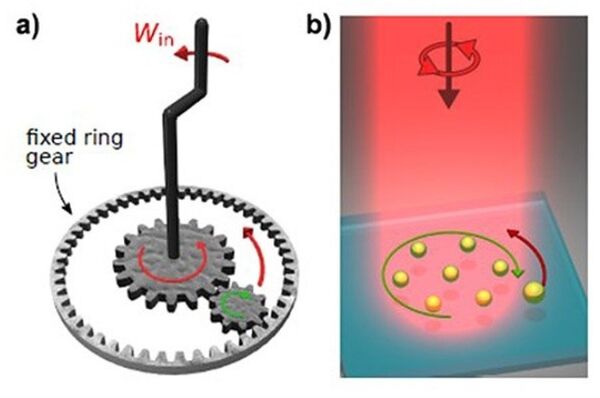
Nanoscale Machines Convert Light into Work
"Based on optical matter, new machines could be used to move and manipulate tiny particles Researchers have developed a tiny new machine that converts laser light into work. These optically powered machines self-assemble and could be used for nanoscale manipulation of tiny cargo for applications such as nanofluidics and particle sorting. “Our work addresses a long-standing goal in the nanoscience community to create self-assembling nanoscale machines that can perform work in conventional environments such as room temperature liquids,” said research team leader Norbert F. Scherer from the University of Chicago. Scherer and colleagues describe the new nanomachines in Optica, The Optical Society's (OSA) journal for high-impact research. The machines are based on a type of matter known as optical matter in which metal nanoparticles are held together by light rather than the chemical bonds that hold together the atoms that make up typical matter. “Both the energy for assembling the machine and the power to make it work come from light,” said Scherer." [...]
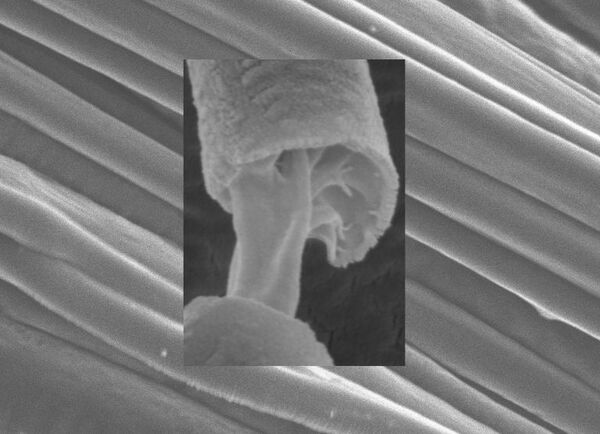
Layer of Strength, Layer of Functionality for Biomedical Fibers
"Wound dressing, tissue scaffolding, controlled and sustained drug delivery, and cardiac patching are all biomedical processes requiring a material that combines strength with functionality. Core-sheath polymer fibers, fibers comprised of a strong core surrounded by a biologically applicable sheath layer, are an affordable way to meet these requirements. In the journal Applied Physics Reviews, from AIP Publishing, researchers from University College London discuss methods of producing core-sheath polymer fibers and their promising applications. Those polymers are beneficial, because they bypass the need to search for one single material that meets all the necessary criteria, which can be next to impossible. “You want strength, but you also want bioactivity,” said Mohan Edirisinghe, one of the authors on the paper and Bonfield Chair of Biomaterials at UCL Mechanical Engineering. “So, if you align them in a core-sheath polymer, you have the strength of the core material, but the functionality comes from a bioactive polymer or ingredient that is in the sheath." [...]

HKU Engineering team develops novel miniaturised organic semiconductor - an important breakthrough essential for future flexible electronic devices
"Field Effect Transistors (FET) are the core building blocks of modern electronics such as integrated circuits, computer CPUs and display backplanes. Organic Field Effect Transistors (OFETs), which use organic semiconductor as a channel for current flows, have the advantage of being flexible when compared with their inorganic counterparts like silicon. OFETs, given their high sensitivity, mechanical flexibility, biocompatibility, property tunability and low-cost fabrication, are considered to have great potential in new applications in wearable electronics, conformal health monitoring sensors, and bendable displays etc. Imagine TV screens that can be rolled up; or smart wearable electronic devices and clothing worn close to the body to collect vital body signals for instant biofeedback; or mini-robots made of harmless organic materials working inside the body for diseases diagnosis, target drug transportations, mini-surgeries and other medications and treatments. Until now, the main limitation on enhanced performance and mass production of OFETs lies in the difficulty in miniaturising them. Products currently using OFETs in the market are still in their primitive forms, in terms of product flexibility and durability." [...]
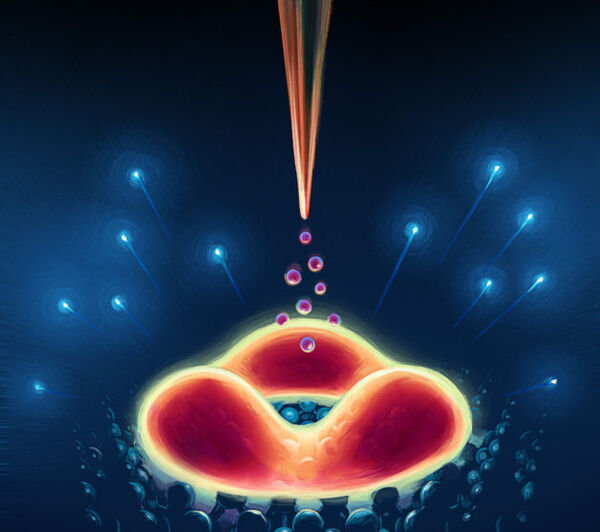
An Electrical Trigger Fires Single, Identical Photons
"The precisely controlled photon source, made from an atomically thin semiconducting material, could aid the development of advanced quantum communication Secure telecommunications networks and rapid information processing make much of modern life possible. To provide more secure, faster, and higher-performance information sharing than is currently possible, scientists and engineers are designing next-generation devices that harness the rules of quantum physics. Those designs rely on single photons to encode and transmit information across quantum networks and between quantum chips. However, tools for generating single photons do not yet offer the precision and stability required for quantum information technology. Now, as reported recently in the journal Science Advances, researchers have found a way to generate single, identical photons on demand. By positioning a metallic probe over a designated point in a common 2D semiconductor material, the team led by researchers at the U.S. Department of Energy’s Lawrence Berkeley National Laboratory (Berkeley Lab) has triggered a photon emission electrically." [...]
Documentação
A documentação é parte essencial do processo de aprendizagem e a Internet além de artigos interessantes de explorar também tem alguma documentação em formato PDF interessante de ler. Todos os links aqui apresentados são para conteúdo disponibilizado livremente pelo editor do livro.

newelectronics 13 Outubro 2020
"New Electronics is a fortnightly magazine focusing on technological innovation, news and the latest developments in the electronics sector. Downloadable as a digital page turner or pdf file, or offered as a hard copy, the New Electronics magazine is available in a format to suit you. " [...]
Projetos Maker
Diversos Projetos interessantes.

8 Channel Infra-Red Remote-Control Arduino Shield Using ULN2803
"This is an 8 channel infra-red remote-control Arduino shield that can drive 8 high current loads such as LEDs, solenoids, multiple toy DC Motors, dual unipolar stepper motor, filament lamps, etc. Each channel consists of two parallel NPN transistors with freewheel diodes which are important to drive inductive loads like motors. The shield consists of 2 x ULN2803 Chips, Infrared receiver TSOP1838, trimmer potentiometer, 4 tactile switches with pull-down resistors. The shield is compatible with Arduino UNO. Arduino code is also provided to test the shield. I have used a cheap IR remote to test this shield, this remote transmit NEC code but any other remote can be used with this shield and it will require to decode the remote switches." [...]
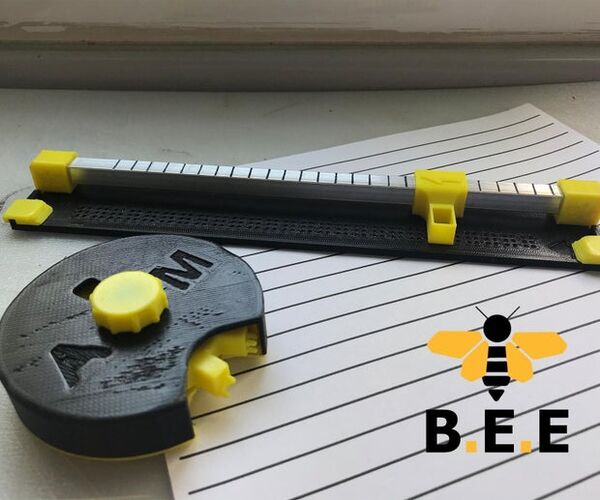
Write in Braille With B.E.E! - DIY Braille Embosser
"Braille as a form of communication has always interested me greatly- so when I saw a contest about making Tools, I took it as an opportunity to develop an idea that I had been thinking about for the past year or so. When researching how Braille worked and the tools that were used to generate said writing, I was surprised to see how expensive they were. It was as if there were two price ranges: Very expensive and very precise (we are talking upwards of $2000) Very cheap and not very precise For Braille to be read quickly and easily, there are a series of dimensions one must follow (such as the distance between bumps, from the edge of the paper etc.). As such, I thought that a tool that would be very useful would be one that was cheap and even Open Source, whilst also capable of stimulating the interaction between the blind and those who aren't. With that in mind, our team developed B.E.E (which stands for Braille Embossing Experience). Our goal was to create a tool for embossing which could be made at home, would cost less than $5 to make, and could be carried inside a backpack without disrupting any usual movements." [...]
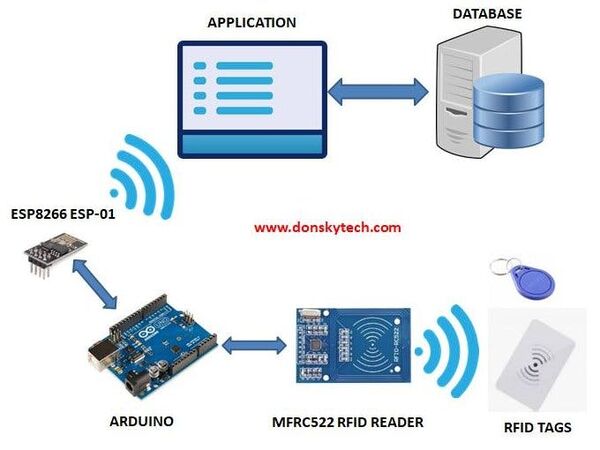
Arduino RFID Database Security System with ESP8266 ESP-01
"In this article we are going to discuss the designing process of our Arduino Radio Frequency Identification (RFID) Database Security System Project. This will walk you through the way I design my own RFID Project that connects to the database to verify if an RFID tag is allowed or not. There are lots of tutorials online that I have read about this and I seem to be confused on some of the stuffs that are being discussed. This is my own design process on how I would create the project and I am hoping that beginners could get something from this. I have divided this project into several post so as to focus on the important stuff per each post. Designing the Project Create database to store our RFID code using SQLLite Create the application that would interact with the database Putting it all together" [...]
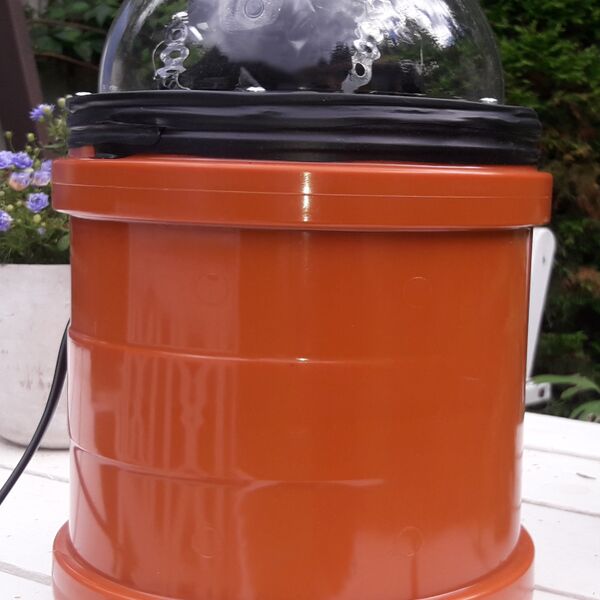
Cheap All Sky camera project with Raspberry Pi
"All Sky meteorite camera build under 150$. My friend Jani made a program to capture night sky events with cheap Raspberry Pi hardware. Now the program is out of beta and new version supports all Raspberry Pi versions and camera modules. So i build my first All Sky camera prototype using Raspberry Pi 4 and 13.2 megapixels Raspberry Pi HQ camera with some 180 lens. My goal was to build fully automated high quality night sky / meteorite camera with temperature control inside dome. After some days of testing with one Raspberry Pi 4 and Meteotux PI." [...]

I made an optical inline fuel sensor
"We could automatically detect whether the racing mower is about to run out of fuel by shining a light through a section of clear fuel hose with a sensor on the other side. The idea is that when the fuel has disappeared the received light intensity will change, and we can detect this with a microcontroller. We can then turn on an LED on the dashboard to alert the driver so that he makes a pit stop instead of spluttering to a halt at the opposite end of the track. If you want to see a video of it in action, I have this video but it's not a very good video. You can get the Arduino code and housing CAD files on my github project. This is a good design for the fuel sensor, in my opinion, because the fuel is entirely contained within off-the-shelf parts that are designed to contain fuel and never touches any custom parts, which means the chances of causing a leak or fire are low." [...]

Vectron Handheld
"Vectron Handheld is a retro handheld gaming console based on the 6502 CPU. It has five input buttons (up, down, left, right, fire) and a 1.8" 128x160 18-bit color TFT LCD display. I have developed an implementation of Pong to demonstrate Vectron Handheld's capabilities. How It Works The KiCad design files are available here. The W65C02 is clocked at 8MHz. The console has 32KB of RAM, and 32KB of ROM is available to store the game." [...]

ATtiny85 Mario Challenge!
"The ATtiny85 microcontroller is a capable but compact AVR. However with only 8K of program memory, 512 bytes of EEPROM, 512 of SRAM and only 8 pins (3 of which are dedicated to the usual suspects of Vcc, GND and RESET), it best suited to performing tasks where memory demands are not large, and only a few pins are required for interfacing. Sounds boring! Can we push one the capabilities of the ATtiny85 and play a version of Mario on it? Can we add music? How about sound effects playing at the same time?" [...]
NeoPixel Party Bike - Music Reactive Light Animations With Controller
"I made my NeoPixel Party Bike for two reasons: First, I've worked on a few simple NeoPixel projects in the past and it was like a "tease" that made me want to know more-more-more! Second, I'm a member of BikeJC, a bicycle club in Jersey City that goes on rides at night throughout the summer. Most members light up their bikes with off-the-shelf bike lights - but I've been wanting to apply my hacker skills to my bike -- and make it epic! I designed this project as my own personal "school" - my goal is to learn more about NeoPixels, music visualizations, and BLE. I already learned a lot and I'm happy to share it with you! I put in the time to make the physical hardware durable so that I can continue to deepen my knowledge of code, run tests, and try new skills on the same equipment - I think of it now as my "canvas for learning and testing"!" [...]
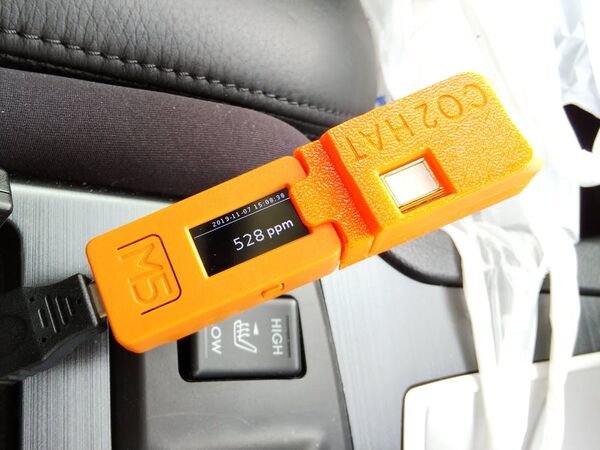
CO2 meter using M5StickC
"I made a CO2 concentration meter for the purpose of room ventilation guide. The CO2 sensor is MH-Z19B, NDIR type. Cause I've been working at home and being cooped up in my room, I decided to make a CO2 meter as a guide to ventilate my room. A MOX gas type that called CCS811 showed inappropriate results for measuring actual CO2 concentration, such as higher readings due to human farting, so I use a high-precision NDIR-type MH-Z19B in this case. I designed all of these to fit inside the enclosure for safe use. I designed the board in KiCAD, ordered the board from FusionPCB, and 3D printed the enclosure using the same orange-colored filament as the M5StickC." [...]

ESP32 Internet Radio
"Dear friends welcome to another project video! Today we are going to build an ESP32 Internet Radio device with a big 3.5” display using an inexpensive ESP32 board. Believe it or not, we can now build an ESP32 Internet Radio in less than 10 minutes and with less than 30$. There is a lot to cover so, let’s get started! Hello, guys, I am Nick and welcome to educ8s.tv a channel that is all about DIY electronics projects. In this channel, I share everything about the projects I build to help you develop similar projects or inspire you to start making things because it is easy, fun and creative." [...]
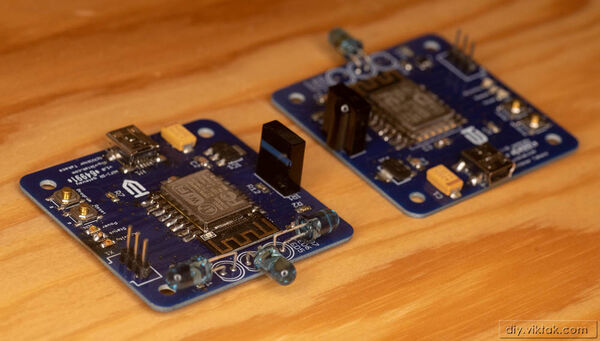
WiFi – IR Gateway a.k.a. Give your Dumb (Old) Devices the Smarts!
"Some time ago I also completed this project that I never got around to publish. This project is a WiFi-Infrared gateway. I am aware that such commercial products exist, but at the time I needed one for my home the available options all suffered from one or more shortcomings, such as being open source, working with my own (very old) IR-capable devices, cheap (I wanted several pieces, one for each room in my house), etc. So I decided to build my own. this also had the added benefit of learning about IR communications, etc. Below is a recap how I went about it, what difficulties I have encountered and a detailed description of the project should one want to make one." [...]
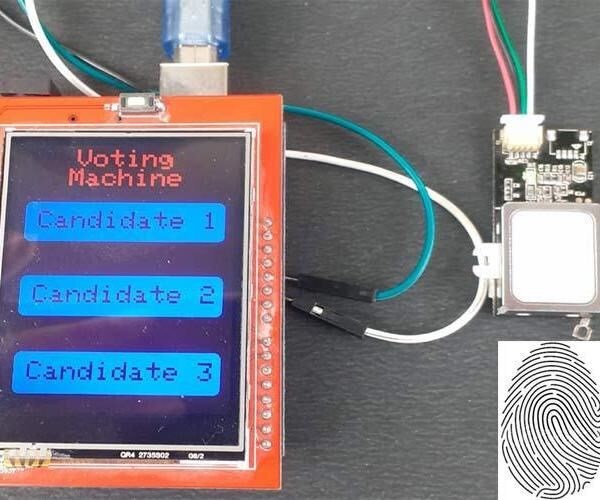
Fingerprint Based Biometric Voting Machine Using Arduino
"We all are aware of the existing electronic voting machine where the user has to press a button to cast the vote. But these machines have been criticized for tempering since the beginning. So the government is planning to introduce a fingerprint-based voting machine where users can cast the vote based on his/her fingerprint impression. This system will not only remove the possibility of duplicate votes but also prevent any kind of manipulation. So in this project, we are going to build a prototype of a Biometric voting machine using the Arduino Uno, TFT display, and Fingerprint Sensor. We previously used R305 Fingerprint Sensor with NodeMCU to build a Biometric based Attendance System but here we will use the advanced GT-511C3 fingerprint sensor with Arduino." [...]
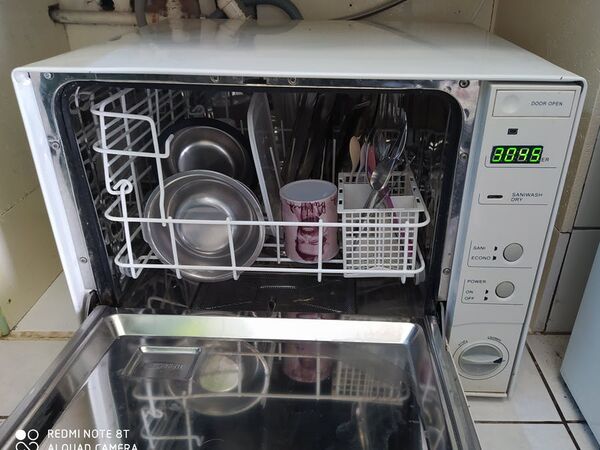
Upcycling Dishwasher
"I used an Arduino Nano to fix my dishwasher. Story I had that all-high-voltage oldie dishwasher that stopped working. Its program switch has burned and I could not find the replacement part. But it is a quite good challenge for an Arduino project. :) Plan: Connect the switches directly to Arduino like door, water lever switches Replace dumb thermostat by thermistor to allow different temperature operations Manage high voltage stuff by relay board like motor, heater, water valve Add LED output and USB connector to the front panel Switches I decided to switch +5V and use pulldown resistors for each. Thermistor I have found many good descriptions on the web for that part." [...]
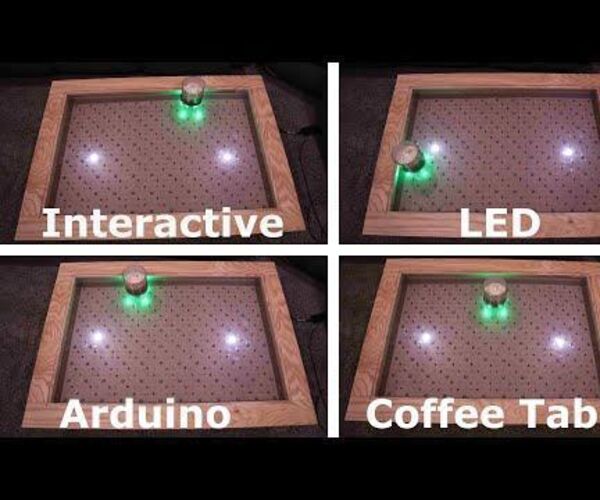
Arduino Interactive LED Coffee Table
"I made an interactive coffee table that turns led lights on under an object, when the object is placed over the table. Only the leds that are under that object will light up. It does this by effectively using proximity sensors, and when the proximity sensor senses that an object is close enough, it will light up a node underneath that object. It also uses an Arduino to put on animations that don't need the proximity sensors, but add a really cool effect that I just love. The proximity sensors are made up of photodiodes and IR emitters. The emitters use infrared light (which the human eye cannot see) to shine light up out of the table, and the photodiodes receive the infrared light reflected off an object." [...]
Vehicle Position Tracking System
"The autonomous device will send the vehicle position to the android app with time and will show the location on google maps. This project will keep track of the numerous vehicle running in various routes.This project also alerts the authorized person in case of any emergency situation like breakdown, accidents etc by notification. And by the notification we can also give the precise location of vehicle for immediate assistance. Values displayed on the application: Latitude and longitude value google maps. Temperature value X, Y and Z coordinates LCD" [...]

How to DIY 32 Band LED Audio Music Spectrum Analyzer Using Arduino Nano at Home #arduinoproject
"Today we will make a 32 band LED Audio Music Spectrum Analyzer at Home using Arduino, it can shows frequency spectrum and play muisc at the same time. Note The max7219LED must be connected in front of the 100k resistor, otherwise the noise of the speaker will be very high. " [...]

Reverse Vending Machine (RVM)
"Designed a machine in which the user can dispose plastic and metal waste and redeem points to collect rewards by scanning the QR code. MOTIVATION: Where Do Plastic Water Bottles End Up? In landfills, floating on oceans, or rivers and on sidewalks. It was approximated that 46, 000 pieces of plastic trash are floating on the ocean per square mile. This plastic is killing animals, leaking chemicals and disrupting ecosystems. Each bottle can take up to one thousand years to decompose, leaking dangerous and harmful chemicals during the process." [...]
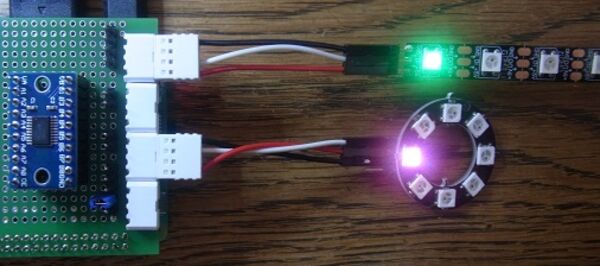
Raspberry Pi 16-channel WS2812 NeoPixel LED driver
"WS2812 LEDs (‘NeoPixels’) are intelligent devices, that can be programmed to a specific 24-bit red, green & blue (RGB) colour, by a pulse train on a single wire. They are capable of being daisy-chained, so a single pulse line can drive a large number of devices. The programming pulses have to be accurately timed to within fractions of a microsecond, so conventional Raspberry Pi techniques are of limited use; they can only handle a small number of pulse channels, driving a maximum of 1 or 2 strings of LEDs, which is insufficient for a complex display. This blog post describes a new technique that uses the RPi Secondary Memory Interface (SMI) to drive 8 or 16 channels with very accurate timing. No additional hardware is needed, apart from a 3.3 to 5V level-shifter, that is required for all NeoPixel interfaces. " [...]
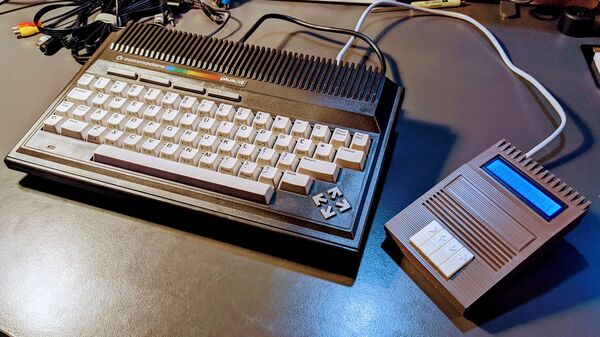
TEDuino: A Modern TED (264) Series Commodore Datasette
"As part of my Commodore Plus/4 series, chapter three of the user’s manual includes a section on using a Commodore Datasette. In a previous post, I assembled the modern replacement for the Datasette, the Tapuino. “What’s a Tapuino,” you ask? It’s an Arduino-based replacement for the Commodore Datasette. For this project I use another Arduino, in this case the inexpensive Arduino Nano version, some easy to source electronic components, and a 3D printer to create a Commodore 264 series inspired Datasette replacement I call, the TEDuino. The TEDuino is powered by the Tapuino project." [...]

WiFi NodeMCU ESP8266 Google Clock
"A simple easy WiFi clock using "Google" timestamp, with temperature and humidity. Oct2020 update: bug fixing and automatic brightness I made several clock with arduino but was looking simple, easy, light, synchronized in real time with internet clock different than NTP" [...]
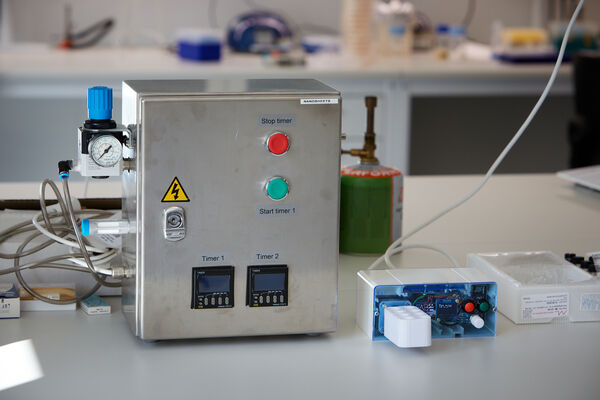
Nano sheet factory
"Sometimes even very expensive and well build equipment breaks. This recently happened to researcher Biljana Mojsoska, a chemist at Roskilde University. She was working with nano sheets, an anti-bacterial coating for medical surfaces, as her machine stopped working. The fact that such equipment can be so expensive to replace or repair triggered Jakub Klust and Bo Thorning at Fablab RUC. Could they build a machine with the same functionalities, using the equipment available at FabLab RUC? Would it be possible to build a much cheaper and easier to fix version of Biljana Mojsoska machine?" [...]
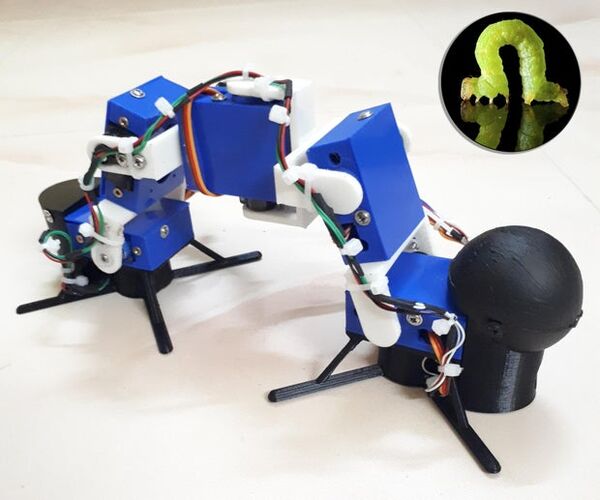
Inchworm Robot - Modular, Move Allsides With BT App
"All the robots are the inspiration of some natural things. In worms, Inchworm has some special features its walk quickly and its so cute. The dream about making inchworm robot is start when i am 15 years old in my school days, i never see the inchworm before. In a Camp when sitting on the ground at the first time i see inchworm. I like it very much. But now a days i see lakhs of inchworms in our factory, even though i like it very much." [...]
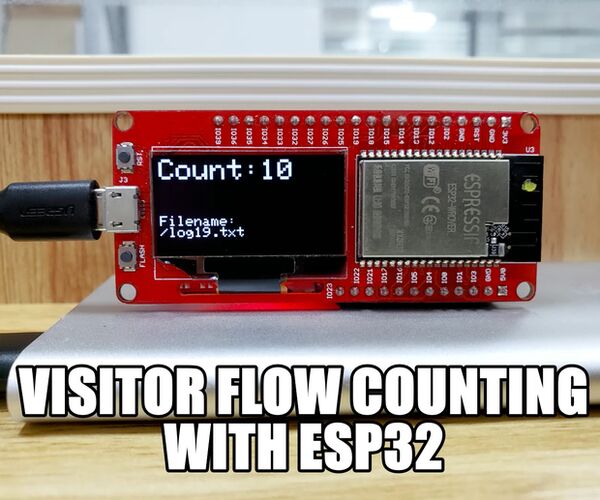
Visitor Flow Rate Counting With ESP32
"Last weekend I went to my friends milk tea shop to help because the business was so hot that he didn't arrange enough clerks. In order to reasonably arrange the working hours of the clerk, I Build a counter to help him count the changes in the number of customers. Supplies: Hardware: MakePython ESP32 MakePython A9G GPRS/GPS Expansion Micro USB cable Micro SD Card Software: Arduino ESP32 is work in a promiscusous mode that this clever chip allows IEEE802.11 network packets capturing for further analyzing. Presented sniffer requires a callback function that will process all received promiscusous packets. Example callback function displays few basic information like packet type (control packet, management packet, etc. ), RSSI or MAC addresses." [...]
thirtytwopixels
"Hardware Raspberry Pi Zero WH Adafruit RGB Matrix Bonnet A 32x32 LED matrix with a HUB75 connection (available on e.g. Adafruit, Pimoroni, Aliexpress). I used this one. A 5V 4A power adapter Refer to the Adafruit instructions to set it up. I recommend to do the PWM mod, it completely removed noticeable flicker for me. This requires minor soldering." [...]
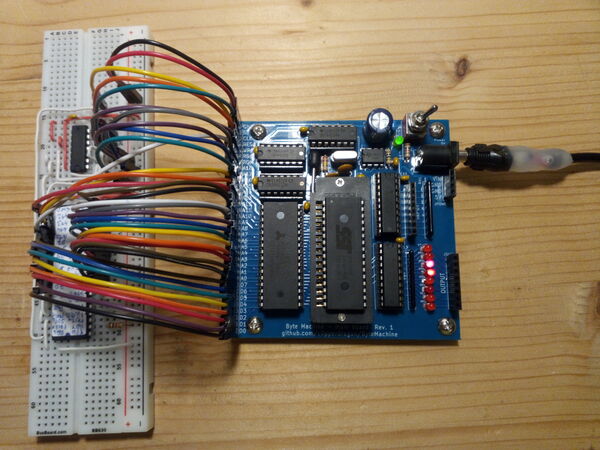
ByteMachine
"Building an 8-bit computer is not exactly trivial. There are always many components involved which are normally connected to some common address and data bus with complex control signal timings for RAM, ROM and IO controller parts and whatnot. One common way for a hobbyist user to actually build such a contraption is using a pre-engineered PCB on which to solder all necessary parts. While this can be great fun in itself, it does not teach you much about the hardware beyond basic soldering skills. Another way is creating the whole computer totally on breadboards. There are great resources and instructions available for this and it may actually give you the best learning experience." [...]

USB-C Powered Bench Power Supply
"A bench power supply is an essential tool to have when working with electronics, being able to set the exact voltage your project needs and also being able to limit the current for when things go to plan really useful. This is my Portable USB-C Powered Bench Power Supply, a surprisingly capable bench supply that is powered using USB-C Power Delivery. This is a really simple build that should only take a couple of hours to make and the best part, it cost less than $12 including shipping! Supplies: USB-C Power Delivery Module PSU Unit Banana Jacks Terminals Power Switch" [...]

How to Make a PCB Business Card
"Hey guys! I Hope you already enjoyed my previous post about "Bluetooth AT Commands Settings" and you are ready for a new one, as usual I made this tutorial to guide you step by step while you make your own PCB business card since I find it as an amazing project that combines both electronics learning and PCB designing and it could be a good start for beginners to upgrade them making skills. During the making of this project, we tried to make sure that this post will be the best guide for you in order to help you if you want to make your own PCB Business Card, so we hope that this post contains the needed documents. This project is so handy to make specially after getting the customized printed circuit boards that we’ve ordered from JLCPCB to improve the appearance of our Business Crad and also there is enough documents and codes in this guide to allow you create your beautiful business card. We've made this project in just 2 days only, just one day to get all the needed parts and finish the hardware making and the assemble, then one day to prepare the code to suit our project. What you will learn from this project : Making the right hardware selection." [...]

Build a Simple Bicycle Turn Signal
"With the advent of fall, it's sometimes hard to realize that the days have become shorter, although the temperature may be the same. It's happened to everyone- you go on an afternoon bike trip, but before you're halfway back, it's dark and you're thrown into a game of hide-and-seek with every other vehicle on the road. Why not let the world know which way you're going turn at the next intersection by building a simple and low-cost turn signal? This project is for people who need a safer way to bike at night. It's easy to make, works great, and is the perfect way to learn about basic woodworking, electronics, and programming. So, if you'd like to get started, read on!" [...]
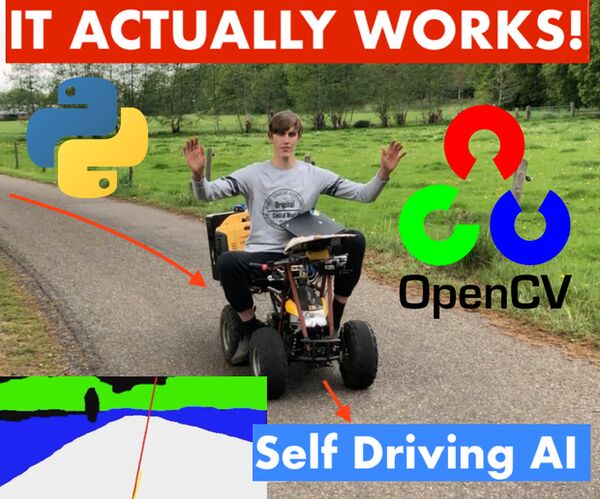
How You Can Make a Fully Autonomous Self Driving Vehicle With Ai, Python and a Camera on a Budget
"We have all seen cool videos of expensive cars like those from tesla and google driving by itself over public roads. While they are very impressive they are out of reach for most makers and DIY'ers. That is why I decided to make my own fully autonomous vehicle which uses some of the same advanced Ai and computer vision technologies that tesla, google and other companies use for their autonomous driving but for a fraction of the price! In this project I am going to show you how you can turn any electric vehicle into a fully autonomous vehicle capable of driving by itself over real public roads! This works by using some advanced Ai detection and Ai learning technologies to make an Ai model predict steering and throttle responses according to the image coming from a camera. To see it work for real and a short introduction on the system, watch the video above." [...]

Throttle Quadrant and Trim Wheel
"A modular 3D printed throttle quadrant and trim wheel for use with flight simulators. Having recently upgraded my PC to enable it to run MS FS2020, I was inspired to improve the controls I was using. A keyboard does not really have the right feel for flying and I wanted to upgrade the experience to something better. I am not a full-time flight simmer and cannot afford the space or money to dedicate a lot to making a full cockpit or even a purchased set of controls. " [...]
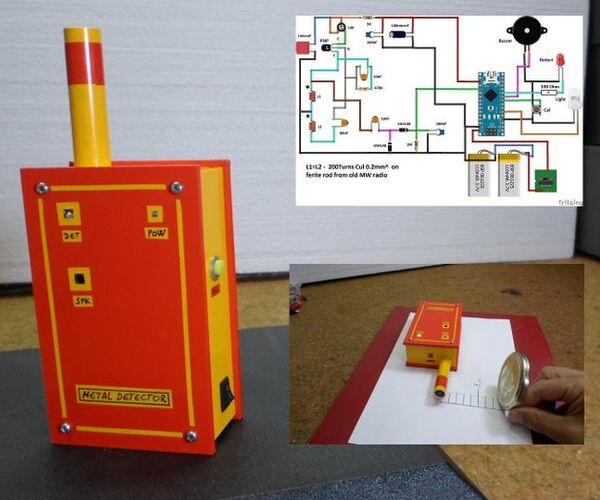
DIY Arduino Pin Pointer Metal Detector
"A traditional metal detector can locate a burried item and give you a rough location of the object belw the ground A pinpointer enables you to pin down an object's location , make a smaller hole when digging , and extract the item. Also, it can be used as Handheld metal detector used by emergency responders to conduct security screening of individuals at access control checkpoints. The device described above is very simple and contains a detector part consisting of a transistor, a ferrite core with windings and several more passive elements, and an Arduino Nano microcontroller with signaling elements and a calibration switch. The method of working with the metal detector is as follows. The device switches on and after a few seconds the calibration switch is pressed. The device is now ready to detect metal objects.If we bring the probe closer to a metal object, the LED starts flashing and the Buzzer emits an intermittent sound." [...]

BikeEverest
"A champion biker from Alaska--Lael Wilcox--in a 21-hour nonstop stretch over the this Memorial Day weekend, made 13 trips up and down a 9-mile stretch of local Hatcher Pass Road to complete the Everest climbing challenge. The goal for participating cyclists: ride the hill of their choice over and over until they climb 29,029 feet the height of Mount Everest. This is a talented biker who held the woman's record for the Continental Divide Race as well as first place finish in the unsupported Trans Am Bike Race. We are very proud of our slim local sports talent pool. To emulate her effort I thought it would be fun to just notch off a few feet here and there and over the course of days, weeks, or months mount my own challenge. For those of you interested in keeping track of arbitrary heights gained with your bike in your casual weekend rides I have provided instructions on how to build a monitor that will eventually announce to the world that you too have completed the Everest Challenge!" [...]

Node.js wireless controlled ROVER
"A wireless ROVER which is controlled by a web-page served by Node.js server, with the help of Sockets. Project Idea Node.js is one of the best options for Real-Time Applications. I have previously worked on some real-time apps using Sockets, so with the same concept, I decided to make some IoT projects with Node.js server for self-learning. This Rover of mine communicates with my Node.js server using Bluetooth and on the front-end, I send commands to the server using Sockets. Project Aim To study and implement wireless communication between Node server and hardware (which is in this case our Rover), and to remotely control the Rover with a mobile web-page served by Node server using Sockets. Prerequisite You need to have some basic knowledge of Node, socket programming, and L298 Motor Driver working." [...]
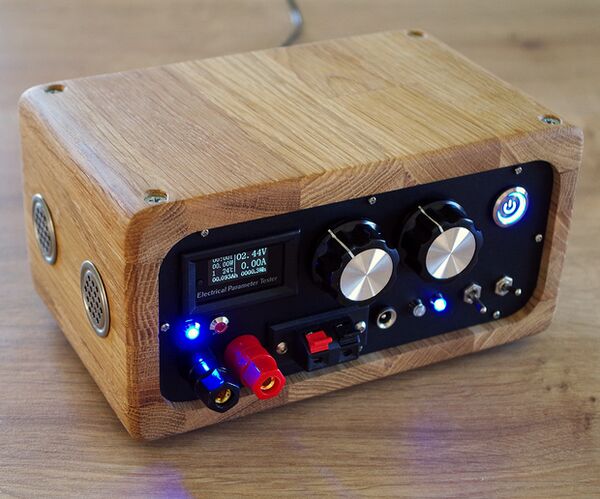
Mini Bench Power Supply - Vintage Style
"I've had too many requests about my mini power supply, so i made instructable for it. I’m in a progress of building new 2 channel power supply, but due to ongoing pandemic the shipping is slow and items keep disappearing. Meanwhile i decided to build temporary and easy PS from parts i had already laying around. Main goals where: - Easy to build - Cheap parts and modules - Easy to upgrade and modify - Look nice on the workbench" [...]

SMD-flipper
"Two stepper motors and an Arduino to turn around an SMD part. For my manual pick and place machine, it would be handy to have a tool that flips SMD parts that are upside down in the storage box. The supplier has such a tool but it is not that cheap, so could I make such a tool myself? Yes... First, my son has designed the needed parts with Solid Works and prepared them for 3D printing. After that, I wrote a test program for driving the stepper motors. I'm using a Arduino Nano Every because of his price and the dimensions." [...]
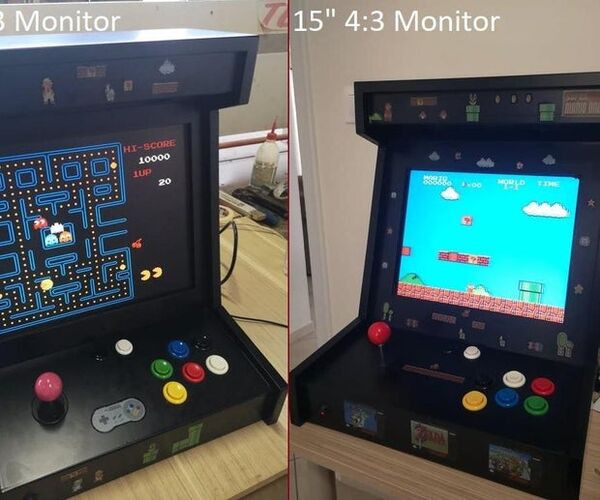
DIY Arcade Box With Raspberry Pi and RetroPie
"Hello everyone! In this Instructables project I will show you how to make your own Arcade Box! I designed it to fit a 15" and 17" 4:3 Monitor and kept its dimensions small so that it does not take up much space. The "heart" of this game machine is the Raspberry Pi running the RetroPie, a front end management application for launching your games! Tutorial updates can also be found here: https://www.ardumotive.com/arcadegameboxen.html Here you can see a video from our Arcade Box! The video is in Greek language but I believe that you will catch the main idea..." [...]
That's all Folks!



